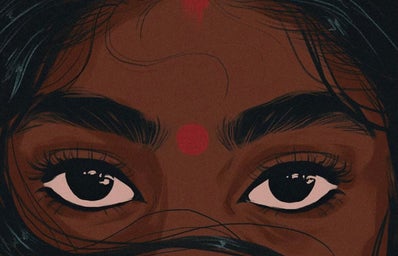Jade Deo’s Instagram feed is a collection of stories about women of color. You can see their body hair and cellulite, but most importantly, you can see their beauty shine through the screen. Jade’s art is unique in that it is a celebration of melanin in a way I had never seen before. I sat down with Jade Deo to ask how she made her art so special.
HerCampus (HC): You envision canonically lighter-skinned or white-passing characters as darker-skinned and draw them as the latter. Why?
Jade Deo (JD): There is no such thing as white erasure. Every time someone feels the need to argue, “But if someone made a brown/black/etc. character white, it’d be a problem,” they make it glaringly obvious that they don’t understand the concept of a power imbalance. It is not the same.
There are countless characters from every genre and medium imaginable that are white, white-passing or fair. The same can’t be said for canonically visibly, darker BIPOC characters.
HC: Do you ever feel pressured to draw characters from a white, Western beauty standard?
JD: Only in the sense of what it could mean for my reach. As I’m sure is no surprise, artists who almost exclusively draw BIPOC struggle a bit more when it comes to the growth of their accounts. Still, I regret nothing of my decision to do so. I have been afforded amazing opportunities because of this aspect of my work and met incredible people, both of which I would not trade for all the growth in the world.
HC: When you first started your Instagram, were there any goals you set out to achieve?
JD: Honestly, I just wanted to post consistently.
Aside from that, last year that goal also became authenticity. I’ve been fortunate enough to spend some time studying abroad in the spring semester of 2020. While in Limerick, Ireland, I had the sweetest theology professor. He has always been a poet, even though he tucked his poems under his pillows while growing up. One day, he decided to give up the shyness and hasn’t looked back since. His love for his culture & artful storytelling struck deep. On the last day of class, I asked that a drawing I had created for him the night before be passed along. The words, “I promise never to hide my poems under my pillows” were written on the back.
I strive to live those words by cultivating my page and my art and to do good by Professor Bond & the vulnerability & truths he inspires in me.
HC: Did you always include darker-skinned women, cellulite, body hair, etc., in your work?
JD: No, unfortunately – at least not as frequently as I do now.
There’s a lot of overlap between my love of both reading and drawing, and I wasn’t always exposed to the same diversity I am now when it comes to those spheres. For the longest time, most of the books I read featured the same cookie-cutter, white lead with the occasional (far less developed) BIPOC side character. I think my art from years ago reflects that, to an extent.
It wasn’t until I started getting more involved with social media and filled my feed with people who I wouldn’t have been able to find represented in books that I started to change.
For example, I was suddenly more conscious of my “brown-ness” and my history. I had a desire to learn & see more. I wanted nothing more than to see the pretty brown girls on my feed, so unapologetically confident in the darkness of their bodies, wild black hair and infinitely deep eyes. I wanted to focus on the culture they wore and exuded simply by taking up space. They were the start, and it permeated my art from there.
HC: In your captions, you tell stories. Where do you draw inspiration for these stories?
JD: My more elaborate concepts usually have backing in some specific idea I want to address. This can be bluntly factual (i.e. Indo-Caribbean history or the significance of the nose ring in South Asia) or more subtle (merging social/cultural themes and fanart). The idea I address at any given time is usually something that’s been on my mind for a while or something I feel should be addressed/given more attention. Many of these “stories” are influenced by my own experiences as a young brown woman, so it always comes from the heart regardless of subject matter.
HC: When Western beauty is the standard to which many brown girls are held, what is one word that would describe the feeling of creating a space in which non-Western, non-White beauty is celebrated?
JD: Pride.
HC: What is something you would hope a follower immediately understands after scrolling through your feed?
JD: My page is and always will be a safe space for every individual who did not/does not see themselves represented in mainstream media. I am not here to cater to white fragility or internalized racism. I will not apologize for the art I create, nor for taking what is given in droves to the majority and adapting it on behalf of the underrepresented minority.
HC: What is something that gives you the strength to continue advocating for the visible representation of darker-skinned women?
JD: It’s the little pockets of change I’ve finally started to see taking shape in our online communities. It’s artists of all backgrounds adding fuzzies to their characters and sprinklings of history here and there. It’s the everyday users I see standing up to whitewashing and featurism and colorism.
It’s every comment and message I receive from the brown-skinned women who finally see their melanin praised, and from the women who see the whorls of body hair in my doodles and can feel even a little better about their own. It is from the women who see their lovely noses showcased for once, and from the South Asian women & the children of that diaspora who feel seen by the featuring of pieces of their beautiful culture. I may or may not have started saving these words because they are so unbelievably precious to me and I sincerely wish I could just absorb them into my soul.
They are a constant reminder that though this world is large, the vibrations through it are far-reaching. It’s such a privilege to be felt at all, and one I do not take lightly.
Want to see more HCFSU? Be sure to like us on Facebook and follow us on Instagram, Twitter, TikTok, YouTube and Pinterest!


